Ancient Amber Captured Something Surprising About This Spider
Recently, researchers published surprising observations discovered while studying ancient Burmese amber. Captured inside 99-million-year-old fossilized tree sap was a lagonomegopid mother protecting her offspring and egg sac. The image is a beautiful and tragic reminder of how mothers, no matter the species, try to protect their children from harm and danger. Inevitably, the female spider, still clutching her egg sac and guarding hatchlings, was blanketed in tree sap, spelling their doom (via CNN).
According to the CNN article, a separate piece of amber shows spiderlings that stayed close together and by their protective mother's side after breaking free from the egg sac. "This is exactly how a living female spider which is nestled in a crevice in tree bark would look (in this case, right before being swamped with tree resin)," wrote Paul Selden, Gulf-Hedberg Distinguished Professor Emeritus at the University of Kansas and author of Maternal care in Mid-Cretaceous lagonomegopid spiders, published in the Proceedings of the Royal Society B: Biological Sciences journal. Although the spiderlings are not well-preserved, micro CT scanning identified them as members of the Lagonomegopidae family, according to the research report.
Timeless maternal love captured in amber
Lagonomegopids are part of the now extinct Lagonomegopidae family and are known for having distinctly large eyes at the front corners of the head, with some species having reflective eyes similar to the cat. The closest reference would be the jumping spider, although they are not related. They materialized approximately 299 to 359 million years ago during the Carboniferous period, according to CNN.
Their characteristics are two large eyes on either side of the anterolateral flanks of the carapace, peg teeth on the promargin of the chelicera, spineless legs, and trichobothria on the leg tarsus. Using micro CT scanning, the mother is seen holding the clearly visible egg sac containing pre-hatchlings. Paternal care in extant spiders are mainly maternal, with the exception of the amphisexual of the araneid Manogea porracea spider. While this fact is widely known, the excitement is over having fossilized evidence, which is rare. "Whereas we expected that spiders had maternal instincts from their very beginning, it is, nevertheless, very nice to have actual physical evidence from the fossil record about 100 million years ago," Selden said (via CNN).

